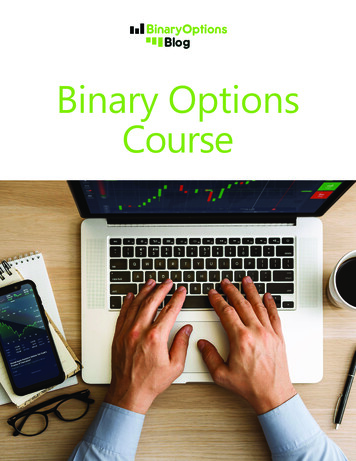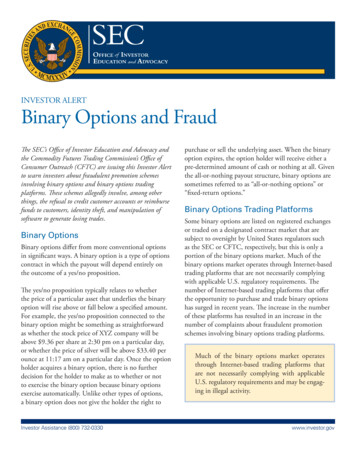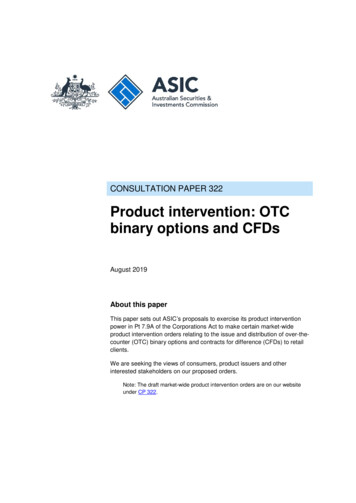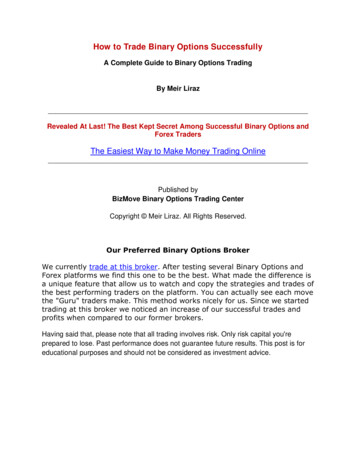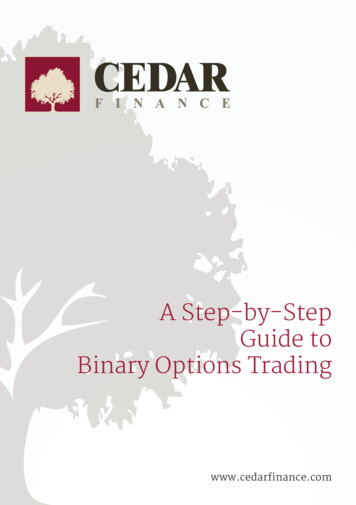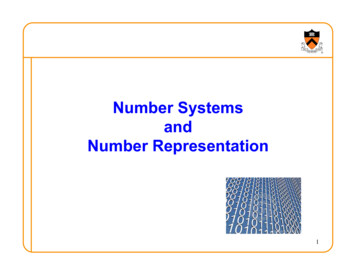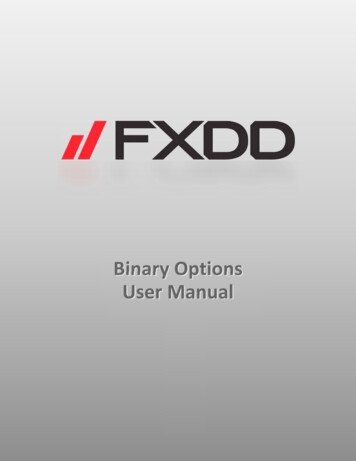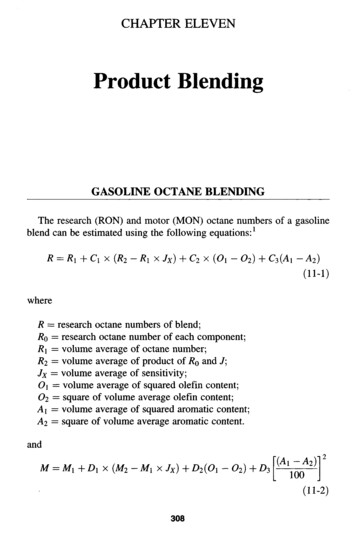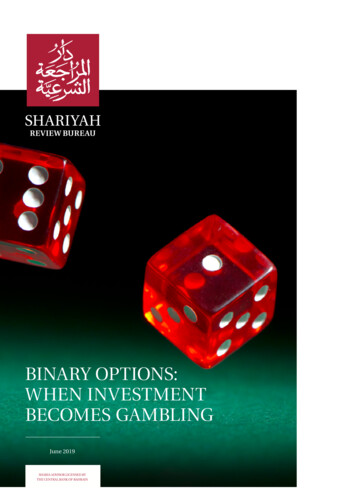
Transcription
Binary Options:When investmentbecomes gamblingJune 2019SHARIA ADVISOR LICENSED BYTHE CENTRAL BANK OF BAHRAIN
2Binary Options: When investment becomes gamblingSHARIYAH REVIEW BUREAUIntroduction to derivativesA derivative is a financial instrument whose valueis derived from an underlying asset or groupof assets. They are a contract between two ormore parties. The value of this contract dependson changes in the value of the asset that thederivative’s value is derived from. Derivatives canalso be thought of as bets on a change in price,or as insurance. Examples of underlying assetsare stocks, bonds, and commodities1. Thesederivatives are linked to a specific financialinstrument or indicator or commodity, andthrough which specific financial risks can betraded in financial markets in their own right.Transactions in derivatives should be treatedas separate transactions rather than as integralparts of the value of underlying transactionsto which they may be linked. Unlike debtinstruments, no principal amount is advancedto be repaid and no investment income accrues.Derivatives are used for a number of purposessuch as risk management, hedging, arbitragebetween markets, and speculation.Derivatives enable parties to trade specificfinancial risks - such as interest rate risk,currency, equity, commodity price risk, andcredit risk - to other entities who are morewilling, or better suited, to take or manage theserisks, typically, but not always, without tradingin a primary asset or commodity. The riskembodied in a derivative contract can be tradedeither by trading the contract itself, such as withoptions, or by creating a new contract whichembodies risk characteristics that match, in acountervailing manner, those of theexisting contract owned.Derivatives contracts are usually settled bynet payments of cash, often before maturityfor exchange traded contracts such ascommodity futures. Cash settlement is a logicalconsequence of the use of derivatives to traderisk independently of ownership of an underlyingitem. However, some derivative contracts,particularly involving foreign currency, areassociated with transactions in theunderlying item.The value of the derivative derives from theprice of the underlying item: the referenceprice. Because the future reference price is notknown with certainty, the value of the financialderivative at maturity can only be anticipatedor estimated. The reference price may relate to acommodity, a financial instrument, an interestrate, an exchange rate, another derivative, aspread between two prices, an index or basket ofprices. An observable market price or index forthe underlying item is essential for calculatingthe value of any financial derivative. If thereis no observable prevailing market price forthe underlying item, it cannot be regarded as afinancial asset 2.Derivative products initially emerged as hedgingdevices against fluctuations in commodity prices,and commodity-linked derivatives remainedthe sole form of such products for almost threehundred years. Derivatives came into spotlightin the post-1970 period due to growing instabilityin the financial markets. However, since theiremergence, these products have become verypopular and by 1990s, they accounted for abouttwo-thirds of total transactions in derivativeproducts. In recent years, the market for financialderivatives has grown tremendously in termsof their variety, complexity and turnover. In theclass of equity derivatives, futures and optionson stock indices have gained more popularitythan on individual stocks, especially amonginstitutional investors, who are major users ofindex-linked derivatives. Even small investorsfind these useful due to high correlation of thepopular indexes with various portfolios and easeof use. The lower costs associated with indexderivatives vis–a–vis derivative products basedon individual securities is another reason fortheir growing use3.1 Stefanie Strack, ‘AN INTRODUCTION TO DERIVATIVE MARKETS’, n.d.,Available online2 ‘What Are Derivatives ?’, accessed 2 October 2018, vatives.htm. IMF (1998), FinancialDerivatives, EleventhMeeting of the IMF Committee on Balance ofPayments Statistics, Available from: f3 7-46.Pdf’, accessed 2 October 2018, 7-46.pdf
3Binary Options: When investment becomes gamblingSHARIYAH REVIEW BUREAURecently, the dangers and risks embedded inderivatives have come to the forefront. A majorreason for this is because of counter-party risk.Most derivatives are based on the person orinstitution on the other side of the trade beingable to live up to the deal that was struck. Ifsociety allows people to use borrowed moneyto enter into all sorts of complex derivativearrangements, we could find ourselves ina scenario where everybody carries thesederivative positions on their books at largevalues only to find that, when it’s all unravelled,there’s very little money to circulate becausea single failure or two along the way wipeseverybody out with it. The problem becomesexacerbated because many privately writtenderivative contracts have built-in collateral callsthat require a counterparty to put up more cashor collateral at the very time they are likely toneed all the money they can get, acceleratingthe risk of bankruptcy4.The following three broad categories ofparticipants - hedgers, speculators, andarbitrageurs trade in the derivatives market.Hedgers face risk associated with the price ofan asset. They use futures or options markets toreduce or eliminate this risk. Speculators wishto bet on future movements in the price of anasset. Futures and options contracts can givethem an extra leverage; that is, they can increaseboth the potential gains and potential losses in aspeculative venture. Arbitrageurs are in businessto take advantage of a discrepancy betweenprices in two different markets. If, for example,they see the futures price of an asset gettingout of line with the cash price, they will takeoffsetting positions in the two markets tolock in a profit.4 Joshua Kennon, ‘What Is a Derivative and How Do Derivatives Work?’, TheBalance, accessed 2 October 2018, -how-do-derivatives-work-358098
4Binary Options: When investment becomes gamblingSHARIYAH REVIEW BUREAUFeatures of a derivatives contractContract:SettlementA derivative contract specifies that some futurecommodity may be exchanged at a later dateat a price fixed today. Notice the fact that theagreement would basically be worthless if notfor the time difference between the setting of theprice and the actual execution of the trade.Since the price is set today, let’s say at 100 andthe transaction takes place a month from nowwhen the price could be any amount greater orlower than 100, the derivative contract becomesvaluable. The derivative contract becomes alicense to purchase commodities at below marketprices and book an immediate gain. Therefore,the value of the contract is derived from thefluctuation in the price of an underlying assetand hence the term derivatives to definethese securities.Theoretically speaking, derivative contracts canbe settled in both cash as well as in kind. Thismeans that the person executing the contracthas the right to ask for delivery of the underlyingcommodity or the amount of money whichis equivalent to the underlying commodity.However, in reality derivative contracts areusually always settled in cash. Asking for deliveryof the underlying commodity is an unheard-ofoccurrence in the modern world.Time Restriction:Since derivatives are contracts, they have anexpiration date. This means that after a certaindate they become completely worthless. Hence,they must be utilized within a given timeperiod or else they do not hold any value. This isopposed to the general notion of financial assets.Financial assets like stocks and bonds usuallyhold value for a much larger period of time.Derivatives on the other hand hold value for anextremely short period of time and this is theirdefining feature.High Leverage:The derivatives contracts are characterized byextremely large leverage ratios. Leverage ratiosof 25 to 1 and 33 to 1 are common while tradingderivatives. This is not a defining feature ofderivatives meaning that a contract cannot becalled a derivative contract just because it ishighly leveraged. However, this is the norm withmost derivative transactions.Zero-Sum Game:Derivative contracts are a zero-sum game. Thismeans that the parties in a derivative contract aredirectly betting against each other. If one partywins, the other party by definition has to lose.This is opposed to the stock market when a risingstock price can be beneficial for everyone whois holding that stock. The fact that derivativescarry a high leverage and are a zero-sum gamemeaning that one of the parties involved has tolose makes it an extremely dangerousfinancial instrument 5.5 ‘ What Are Derivatives ?’, accessed 2 October 2018, vatives.htm
5Binary Options: When investment becomes gamblingSHARIYAH REVIEW BUREAUWhat are Binary Options?Binary options are a type of derivatives contract.The UK regulators Financial Conduct Authority(FCA) have described binary options as “a formof fixed-odds betting. Typically, a trade involvespredicting whether an event will happen or not(for example, will the price of a particular shareor asset go up) and the outcome is either yes orno. If the investor is correct, they ‘win’ and shouldsee a return on their investment; if they’re wrong,they lose their full investment”. In trading binaryoptions, a speculator is predicting whether anasset class will be above or below a certain priceat a certain time.Binary options can go by many other names.On forex or interest rate markets, they are calleddigital options. On the American Stock Exchangethey are called fixed-return options (FROs) orall-or-nothing options. They are commonlycalled ‘binary’ because they offer returns in onlytwo outcomes: something (for example, a preset amount of 100) or nothing. Binary optionsallow you to make bets on financial products(including shares and foreign exchange), marketsor economic events. Binary options are alsocalled “yes or no” investments.If an investor thinks an asset will be above a setprice, they are predicting “yes” and buying thebinary option. If they think an asset class willfall below a set price, they are predicting “no”and selling the binary option. For example, aspeculator could bet on whether the share price ofa company will be trading above its current pricein one hour. Contract times for binary options areusually very short, from a few minutes or hours,to a few months in the future.Binary options generally allow investors to bet onthe price movements of: Stock indexes, like the S&P 500, Nasdaq, Russell2000 and FTSE 100. Forex (currency pairs). Commodities, like precious metals, crude oil,natural gas, soybeans and corn. Individual stocks. Economic events, like the federal funds rate orthe jobs report.
6Binary Options: When investment becomes gamblingSHARIYAH REVIEW BUREAUDifferences betweentraditional vanillaoptions and binaryoptionsBinary options share all of the same underlyingfactors as traditional vanilla options. Whenpricing binary options, the same inputs are usedto determine its value. The only way in whichthey differ is their pay-out structure on expiry. Onexpiry of a binary option, the pay-out of the optionis only one of two outcomes. That is either 0 or 1(100). This is why it is sometimes termed “binary”or “digital.”66 Binary Trading Club (n.d.), Binary Options vs Options, Available s-options/
7Binary Options: When investment becomes gamblingSHARIYAH REVIEW BUREAUDifferent types of Binary OptionsThere are a number of binary options. The most common types are as follows7:1. One Touch2. No TouchThis type of option pays out an investor’sprofit once the price of the underlying assetreaches a predetermined barrier, also knownas a “trigger”. Once the trigger level has beenreached, the trader will receive his payout. Thistype of option is preferred when an investor issure that the asset’s price will perform a strongmove in a certain direction and will hit the triggervalue, disregarding whether the price jump issustainable, or whether the market will retrace.The no-touch option works in the opposite fashionto one-touch options. The investor wages thatthe underlying asset will not reach a certain pricelevel. Just like the one-touch option, the investor,or broker, select a certain price level above orbelow the spot (current) price and bet that theprice will not reach the determined level within theexpiration period. If it does hit it, even once, theoption will instantly become “out-of-the-money”,and vice versa.Unlike the standard binary option where you onlyhave to predict whether the price will go up ordown, here both the direction of movement andthe trigger level are predetermined (some brokersallow traders to set these levels). The investor onlyhas to decide whether the conditions will comeinto fulfilment. Although for the option to be “inthe-money” it will have to touch the trigger levelonly once, the one-touch option is generally riskierthan standard binary options and therefore offersa higher payout. One-touch options will pay outmore money, if the trigger is further away from thespot price. For example, if gold currently tradesat 1 300 per troy ounce, a one-touch option withtrigger at 1 350 will offer a higher return than onewith a trigger at 1 325.As for the return, due to the higher risk they carry,these options can also yield a return of up to 500%,depending on the distance to the trigger value.Both touch and no-touch options offer a higherpayout, if the conditions are harder to fulfil. Notouch binary options offer higher return the closerthe trigger is. Thus, a trigger of 1 325 will pay outmore money than a trigger of 1 350, because thechance of hitting the closer target is higher (therisk for the option to become “out-of-the-money”is greater).7 Binary Tribune, Other Types of Binary Options, Available from: y/types-of-binary-options3. Double One TouchDouble one-touch options follow the same logicas one-touch options. However, here we havetwo triggers, one of each side of the spot price. Anoption will become “in-the-money” if the priceof the underlying asset breaks through one of thetriggers, no matter which one.For example, if gold currently trades at 1 300, andthe trader, or broker, have set the upper trigger at 1 350 and the lower trigger at 1 250, the optionwill be profitable if gold either rises to 1 350, orfalls to 1 250. Conversely, if the price fails to touchany of the two triggers through the expiry time, itwill become “out-of-the-money”. Thus, double notouch options are suitable for conditions of marketconsolidation when the trader is sure that the pricewill accelerate and break out soon, but doesn’tknow in exactly which direction.
8Binary Options: When investment becomes gamblingSHARIYAH REVIEW BUREAU4. Double No TouchDouble no-touch options follow exactly theopposite principle compared to the double-touchoptions. There are two triggers here as well, but forthe option to be “in-the-money” the underlyingasset’s price shouldn’t reach either of them duringthe expiration period. In case one of them is hit,the option becomes “out-of-the-money” andthe trader loses their investment. Thus, tradersgenerally prefer to invest in such an instrumentwhen they expect that the market will consolidatein a tight trading range, which often comes after abuy or sell climax (a strong price spike).5. Paired optionsPaired options are another, more exotic type ofbinary options. They are offered only by somebrokers and are based on the performance of oneasset relative to another. Here the trader choosesa pair of assets from a list and bets which asset willoutperform the other during the selected period.Assets are paired according to their class andsector (these categories must match).
9Binary Options: When investment becomes gamblingSHARIYAH REVIEW BUREAUKey terms in binary optionThe following terms are commonly used in binary option trades:Moneyness: One of the most salient relationshipsto thoroughly understand is where the binarystrike price is in relationship to the underlyingmarket. This feature is known in the field of optiontrading as moneyness. Understanding moneynessof the binary option contract generates the abilityto gauge market sentiment and, along with it, theexpected probability of success of a particularbinary option.There are three key metrics to evaluate:1. At-the-Money (ATM): When the strike price isequal to the underlying market price (the spot).2. In-the-Money (ITM): When the underlyingmarket is greater than strike price. This occurswhen a trader is buying the position. When thetrader is opening a position to sell, the optionis in-the-money when the underlying market isless than the strike price.3. Out-of-the-Money (OTM): This occurs when atrader is opening the position to buy and whenthe underlying market is less than the strikeprice and the strike price is above the spotmarket price. Also when a trader is opening aposition to sell and the underlying market isgreater than the strike price8.Expiration Date: The time that the option expires.Settlement Value: The value of the optionon expiration.Underlying Market Price: This is the actual realtime market price of the underlying contract.Contract: This is the basic unit of a trade of one lot.8 Cofnas, A. (2012), Trading Binary Options, New Jersey: Bloomberg Press9 IbidBid: The premium price that a trader pays foropening to sell a contract, or closing a buy order.Sell: This refers to betting the underlying marketwill go down. A trader puts on an open sell order.It is also the premium price that a trade pays forclosing a position that was bought.Ask: The premium price that a trader pays for anopening to buy a position. This is equivalent toputting on a position anticipating an increase inthe price of the underlying market. It is also theprice paid by a trader who has an open position tosell and wants to close it out.Spread: The difference between the bid and ask.With any new market, the spread will tend to benarrow as more volume increases. In the caseof binary option spreads, the spread has to beinterpreted in terms of the total return.Bid Size/Offer Size: This is the number of positionsbeing bought or sold.Commission Fee: The trader will pay a commissionfee per transaction9.
10Binary Options: When investment becomes gamblingSHARIYAH REVIEW BUREAUExample of a Binary OptionA binary option trade involves three steps10:1. Deciding on an asset or market to trade.2. Deciding on an expiry date or time for theoption to close.3. Deciding to buy or sell the binary option, basedon the strike price and expiration date. Thestrike price is essentially a line in the sand. If aninvestor thinks the asset will be above the strikeprice when the contract expires, they will buythe binary option. If the investor thinks the assetwill be below the strike price, they will sell thebinary option.For example, an investor wants to trade on theS&P 500, and chooses a contract with a strike pricethat’s slightly higher than where the market is rightnow. That strike price is 2,075, and the expirationis 3 p.m. The objective in such a trade is to guessspeculate whether an asset will be above or belowthe strike price at a certain time. The investor inthis example will be speculating whether the S&P500 will be above 2,075 at 3 p.m.? If he thinks it willbe above the strike price, he will buy the option.If he thinks it will be below the strike price, he willsell the option. With binary options, the bid is usedwhen you’re selling a contract, and the offer isused when you’re buying a contract. The bid andoffer prices are always under 100. Let’s say thatin our hypothetical trade, the bid on the S&P 500contract is 35 and the offer is 40. If the investorbuys the binary option, he will pay the 40 offerprice.If he sells the binary option, he’ll sell at the 35 bid price.If he thinks the S&P 500 will be above 2,075 at 3p.m., he will buy the binary option contract for 40. That’s the most he can lose in the trade: If the investor bets correctly, the binary optionsettles for 100. The profit is 60, since he putthe offer price of 40 down (which he will alsoget back). This will be termed “in the money”. If the investor is wrong, and the S&P 500 islower than 2,075 at 3 p.m., the trade settles for 0. He will not win anything, and he has lost the 40 he put down. The investor will be “out of10 O’Shea, A. (2016), Introduction to Binary Options Trading Nerdwallet,retrieved from: ptionstrading/the money.”If instead the investor thought that the S&P 500will be below 2,075 at 3 p.m., he would sell thebinary option: If he is correct, the profit is the bid, or the priceat which he sold the option, which was 35. If he is wrong, and the S&P 500 goes higherinstead, he will lose 65 ( 100 less the 35 bid).
11Binary Options: When investment becomes gamblingSHARIYAH REVIEW BUREAUShariah Analysis of Binary OptionBinary options violate a number of prohibitions in Islamic finance. Binary options are Riba-basedtrades. An investor can unjustly earn more than the money staked. Riba is not just limited to unjustifiedincrement above the principal amount; Riba extends to any unwarranted and unjustified payments too.The classical jurists term such profiteering and premiums as Ribh maa lam Yudhman (profit for which norisk was borne). The pay-outs received in binary options fall under unjustified payments.Unjustified and irregular contractual terms (Shart Fasid) also fall under the purview of Riba. The classicaljurists term irregular contractual terms as Riba Ma’nawi (conceptual). Binary options incorporate nonShariah compliant terms in the trade and are non-Shariah compliant from this perspective too.Another prohibitive feature in binary options is the existence of Gharar (major uncertainty). The pay-outand outcome of trades in binary options are uncertain and unknown to the trading parties. Gharar isprohibited due to the harms it brings to the trading parties and the discord it plants between the hearts ofpeople. Trades and transactions with Gharar disunite the hearts and create animosity among people11.Binary options are also plagued with a key prohibition in Islamic finance of Maysir and Qimar. Theserefer to betting and wagering. Al-Jurjani has defined Qimar as a game where one party gains at theexpense of the other. It is an activity or competition where the gain of one party correlates to the loss ofthe other; one party can only gain if the other loses.Mufti Muhammad Taqi Uthmani states that Qimar consists of two factors:1) payment is certain from one side, but uncertain from the opposite side; and 2) there are only twooutcomes of this activity, either the payment made may be lost or may fetch more money. This activityis underpinned by uncertainty as both parties are unaware of the outcome and what they will receive.Secondly, one party wins at the expense of the other. Thus, Qimar activities have two common features:First, a game of chance where the outcome is dependent on a random or uncertain factor. Second, azero-sum game where one party wins at the expense of the other12. Maysir and Qimar have been explicitlyprohibited in the Qur’an:“They question thee about strong drink (khamar) and games of chance(maisir). Say: In both is greaty sin, and (some) utility for men; but thesin in them is greater than their usefulness”(Qur’an 2:219)11 Jakhura, S. (2006), What makes conventional insurance impermissible andTakaful permissible?, CIEFSA, Available from:12 Habib, F. (2017). The Issue of Speculation in the Islamic Capital Market inJournal of Islamic Economics, Banking and Finance 13 (2) pp 89-101
12Binary Options: When investment becomes gamblingSHARIYAH REVIEW BUREAUA binary option trade typically involves predicting whether an event will happen or not (for example, willthe price of a particular share or asset go up) and the outcome is either yes or no. If the investor is correct,they ‘win’ and should see a return on their investment; if they’re wrong, they lose their full investment.This is clearly a form of Qimar as described above.Dr Mohammed Obaidullah asserts that in options the buyer and seller have diametrically oppositeexpectations. Depending on the actual outcome, one of them will win at the expense of the other. Thegains are therefore in the nature of Maysir, and Maysir cannot occur without the existence of Gharar,being a subset of that larger category. Dr Obaidullah explains that speculating on where randomfluctuations will move the price of an underlying asset or commodity in the future infers that the parties’gains and losses also will be random, demonstrating that dealing in option contracts is nothing morethan a game of chance. Gains are therefore in the nature of Maysir, while the possibility of sufferingdefault after incurring massive losses indicates Gharar. Dr Obaidullah concludes his discussion onoptions by stating that these can be used for speculating on price movements and generate unearnedincome, which violates Islamic norms of financial ethics13.Options being derivatives, are zero-sum games and a form of gambling. Dr Sami Al-Suwailem explainsthat, in a zero-sum game, one party gains at another’s expense, i.e., it is a “transfer of wealth for nocounter-value”; this he opines is “condemned in the Qur’an”. He explains that the direct conflict ofinterest inherent in a zero-sum game may create hatred between the two parties, which is one reason theQur’an prohibits Maysir:“Satan only wants to plant enmity and hatred among youthrough wine and Maysir”(Q6:91)The harms of binary options trading have been recognised by regulatory bodies too. In July 2018, theEuropean Security and Markets Authority (ESMA) banned binary options trading. In ESMA’s words, thereis “a structural expected negative return and inbuilt and unmanageable conflicts of interest” betweenproviders and their clients. Put more simply, binary by name does not equal binary by nature. If themarket moves against them, punters lose their entire stake. But if the market goes their way, they mightonly be able to take home 50 per cent, for example. On top of the skewed odds, many binary providersact as a direct counterparty to their client’s trades — typically in more opaque over-the-counter marketswhere it is hard for punters to independently verify market movements. So the incentive is there to tweakthe price of the underlying instrument when the binary option expires, or extend the term by a fraction ofa second to avoid having to pay out winnings to a successful customer14.13 Iqbal et al. (2012), Application of Options in Islamic Finance, ISRA14 Murphy, H. (2018), Binary Options trading is dead in Financial Times.Retrived from: 1e1a0846c475
13Binary Options: When investment becomes gamblingSHARIYAH REVIEW BUREAUCan there be Sharia compliantBinary Options?Binary options do not serve any economic purposeto the traders besides speculative gain. Hence,there is no alternative contract developed bypractitioners in the Islamic finance industry.Investors and traders have a variety of Shariahcompliant products available in the markets toinvest and make profit according to their riskreturn-maturity needs and appetites.
14Binary Options: When investment becomes gamblingSHARIYAH REVIEW BUREAUConclusionBinary options are a type of derivative. Binaryoptions have been described by regulators asfixed-odds betting. They are known by othernames such as ‘digital options’, ‘fixed-returnoptions’, ‘all-or-nothing options’. They are termedas binary because they offer only two outcomes:a win or loss for the trader. Binary options are notShariah compliant as they incorporate Riba. Thetrader can receive more than the amount stakedwithout a justified reason. Alternatively, he canlose and the broker can gain the funds withoutjustification. Binary options also incorporateGharar as the outcome is unknown to the bettingparties. The outcome is pegged on an uncertainevent. As a result, binary options are zero-sumgames which incorporate Qimar; one party winsat the expense of the other in binary options.Binary options do not serve any economic benefitor risk management objective. They mainly servespeculators. Islamic investors should not investin binary options instead can choose from awide array of Shariah compliant products andinvestments to earn a lawful income.
15Binary Options: When investment becomes gamblingSHARIYAH REVIEW BUREAUABOUT SRBSince our humble beginnings more than 13years ago we’ve grown to include more than 100companies across a host of industries, thousandsof transactional programs, multi-disciplinaryteams and a combined scholarly workforce of35 Sharia Scholars from 19 countries. And we’renot done yet: our Sharia Advisory and ShariaAudit services will continue to improve—servinglocal and international businesses to help themmaintain and manage Shari’a compliance.We’ve been preparing our clients for a newworld in which Sharia Advisory rapidly becomesthe currency of choice. From faster Certificationprograms, to direct Sharia Supervisory access,and perhaps most critically, navigating throughthe economic structures of clients offerings withina matter of days. We’ve have been working hard tohelp clients like you capitalize on opportunities inglobal Islamic financial markets.Today, scores of institutions across nations,covering public and priva
all-or-nothing options. They are commonly called 'binary' because they offer returns in only two outcomes: something (for example, a pre-set amount of 100) or nothing. Binary options allow you to make bets on financial products (including shares and foreign exchange), markets or economic events. Binary options are also
